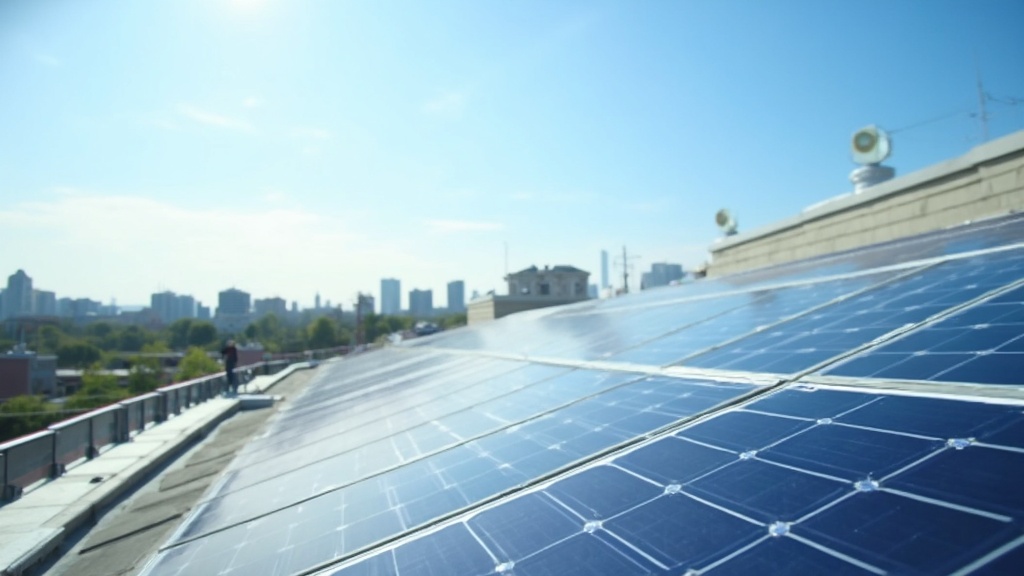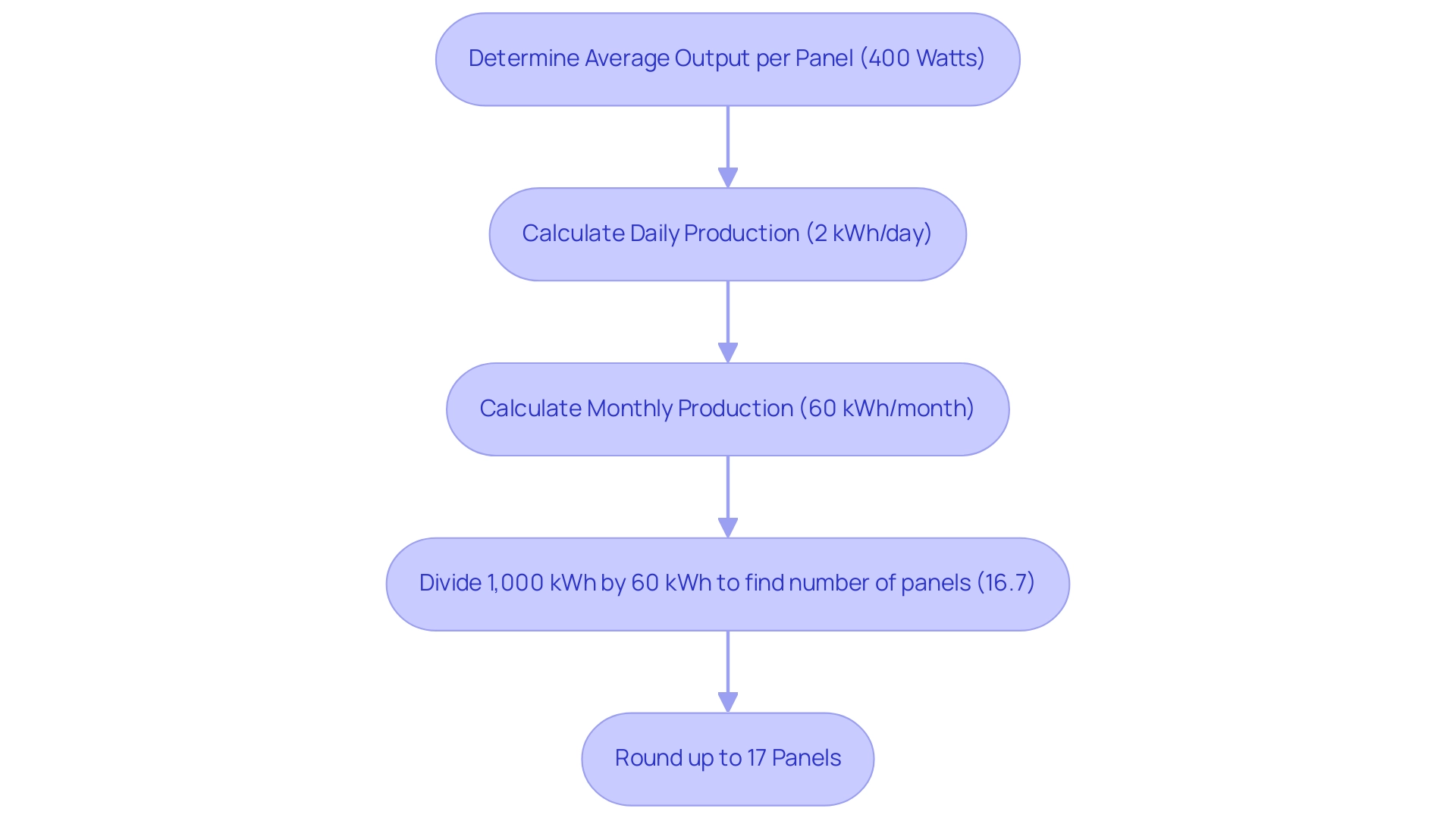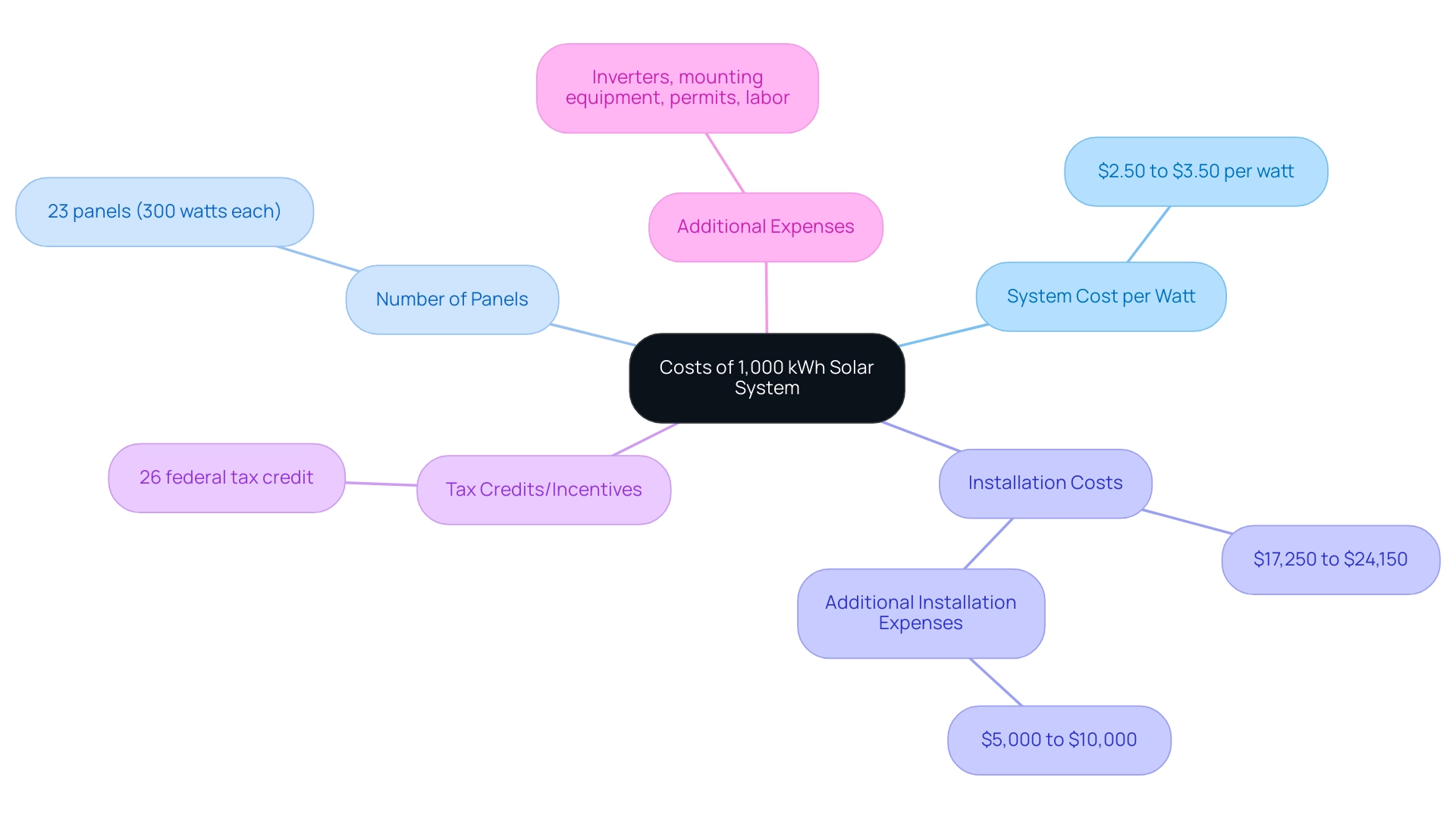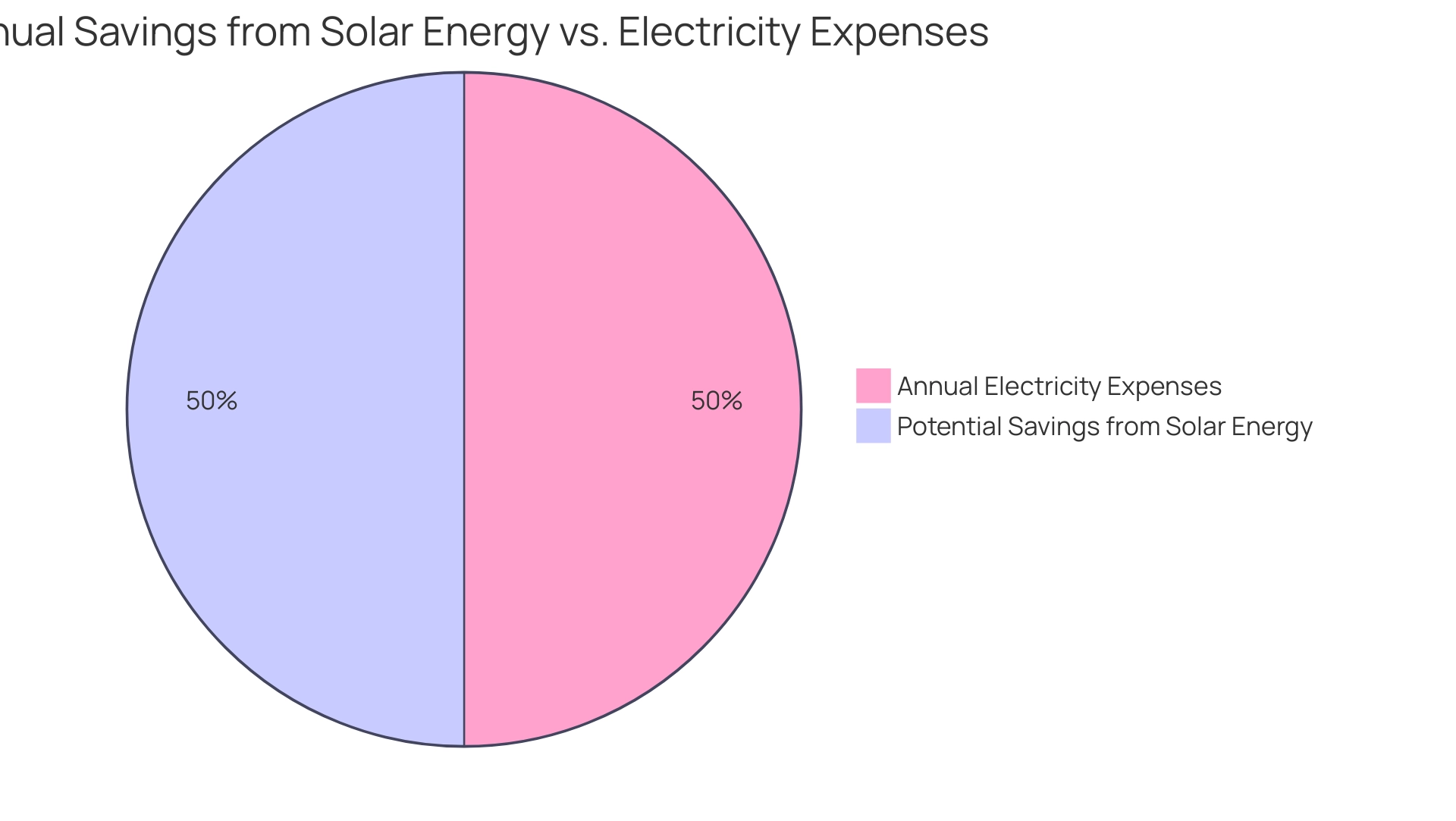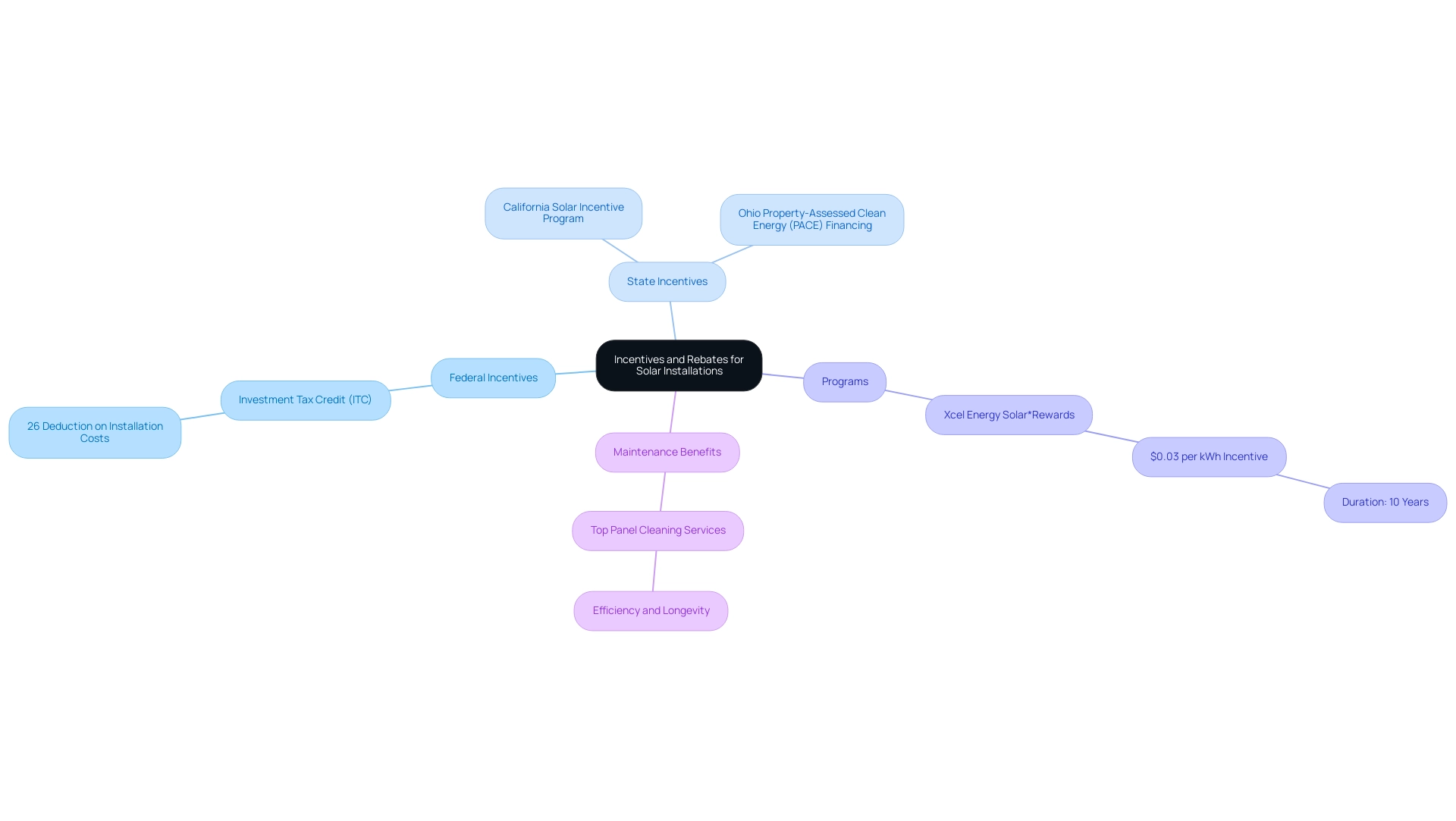Introduction
Navigating the world of solar energy can feel overwhelming, especially for homeowners eager to embrace sustainable living while managing costs. For those in Long Beach, the journey toward installing solar panels involves several key considerations:
- Understanding how many panels are needed to generate a monthly output of 1,000 kWh
- Exploring financing options and available incentives
With the average solar panel output and local sunlight conditions in mind, potential savings and eco-friendly benefits become clearer. This article delves into the essential steps and insights needed to make informed decisions about solar energy investments, helping homeowners not only reduce their electricity bills but also contribute positively to the environment. By breaking down the complexities of solar installations, it aims to empower homeowners with the knowledge to harness the sun’s energy effectively.
Determining the Number of Solar Panels for 1,000 kWh Monthly Production
When determining how many photovoltaic modules you’ll require to meet the 1,000 kWh per month solar system cost, the initial step is to comprehend the average yield of a photovoltaic unit. Nowadays, many residential solar systems boast a capacity of around 400 watts, with ZNShine Solar offering a maximum output of 405 watts. According to the EnergySage Marketplace, “We’ll use 400-watt modules in these calculations because 390-400 W is the most quoted capacity range on the EnergySage Marketplace, according to our latest Solar and Storage Marketplace Report.”
Assuming you receive around 5 hours of sunlight daily, each unit can produce roughly 2 kWh each day, which totals to about 60 kWh monthly. To achieve the 1,000 kWh per month solar system cost goal, you would divide 1,000 kWh by 60 kWh per unit per month, indicating you would require approximately 16.7 units. Realistically, it’s wise to install about 17 units to comfortably cover your energy needs.
Keep in mind that elements such as roof pitch, shading, and orientation can influence energy performance, which may require higher-efficiency units if you have restricted roof space. For Long Beach tenants, it is also essential to investigate government initiatives like the California Solar Initiative and the federal Investment Tax Credit that can assist in reducing expenses and making renewable energy more attainable. Additionally, investing in photovoltaic panels requires consideration of initial costs, sunlight exposure, and your unique circumstances, as highlighted in the case study “Evaluating the Worth of Photovoltaic Panels.”
These adjustments ensure you’re prepared for any variations in sunlight and can maximize your energy investment while contributing to a more sustainable future. Solar energy not only reduces electricity bills but also lowers carbon footprints, promoting a cleaner environment.
Understanding the Costs Associated with a 1,000 kWh Solar System
When evaluating a power system intended to generate approximately 1,000 kWh each month, Long Beach renters should be aware of the 1,000 kWh per month solar system cost, as expenses can vary due to multiple factors. On average, the 1,000 kWh per month solar system cost typically ranges from $2.50 to $3.50 per watt, influenced by the brand and efficiency of the units you select. For a system that requires about 23 panels, each rated at 300 watts (resulting in a total capacity of roughly 6,900 watts), the 1,000 kWh per month solar system cost for installation expenses can be expected to range between $17,250 and $24,150, not accounting for any tax credits or incentives.
The typical expense of a photovoltaic system acquired via solar.com is roughly 6-8 cents per kWh, varying based on the system’s size, kind of equipment, and regional incentives. Additionally, factor in extra expenses such as the installation of inverters, mounting equipment, permits, and labor, which may add another $5,000 to $10,000 to your overall investment. Fortunately, the current federal tax credit of 26% can significantly lower the total cost, making renewable energy a much more appealing option for eco-conscious renters committed to sustainability.
By investing in renewable energy, not only are you reducing your carbon footprint—since a typical vehicle emits around 4.6 metric tons of carbon dioxide annually—but you’re also contributing to a cleaner, healthier environment. California is one of the best states for energy savings due to its high utility rates and abundant sunshine, especially when combined with battery storage options like those from Tesla. Additionally, exploring government programs can provide further financial incentives for renters.
The case study titled ‘Carbon Footprint Reduction through Renewable Energy’ illustrates the financial and ecological advantages of such energy sources, encouraging investment in renewable energy solutions tailored for homeowners.
Exploring Financing Options for Solar Systems
When it comes to accessing energy solutions, Long Beach renters have several financing avenues to explore:
- Cash purchases
- Loans
- Leases
- Power purchase agreements (PPAs)
Each option offers unique advantages and considerations. Choosing a cash purchase is frequently the most economical option in the long term, as it removes financing expenses and enhances savings.
However, many renters may not have the funds available upfront, which is where energy loans come into play, allowing for the cost to be spread over time while still enjoying immediate energy savings.
Leases and PPAs are excellent options for those looking to install renewable energy systems with little to no initial investment. While these alternatives can make solar more accessible, it’s crucial to understand that the overall savings may not match those of a cash purchase or loan in the long term.
As you assess your options, take into account your financial circumstances and long-term goals. Now is an opportune time to invest in sustainable energy solutions, especially with various government programs available to support your journey. For instance, the Federal Housing Administration (FHA) guarantees up to 90 percent of energy loans, easing the financing process for many homeowners.
Additionally, programs like the Solar Investment Tax Credit (ITC) offer substantial tax incentives for photovoltaic installations. John Heinz at Solar Pros emphasizes this point, suggesting that homeowners explore their options:
“Explore your options today at ultra-unlimited.com, or reach out to John Heinz at Solar Pros (johnheinz@solarpros.io) to learn more.”
In 2023, a notable trend emerged where many homeowners chose to install batteries for backup power rather than purely for financial savings, underscoring the growing need for power resilience and independence. Battery alternatives, like the Tesla Powerwall, not only offer backup during outages but also enable homeowners to store surplus renewable power for later use, further improving resource security. However, it’s crucial to keep in mind that there is no assurance that financing for renewable systems will cover its own expenses, as some installers might misrepresent the future price of power and overstate the electricity generation from photovoltaic panels.
As you explore your financing options, keep these insights in mind to make a decision that aligns with both your budget and sustainability goals.
Calculating Potential Savings from Solar Energy
Determining your possible savings from renewable energy is a simple procedure, and it all starts with comprehending your existing electricity expenses. For instance, if you’re paying 12.30 cents per kWh—like many folks in Wyoming—and you consider the 1,000 kWh per month solar system cost, your electricity bill would be around $123. By installing photovoltaic panels that produce the same amount as the 1,000 kWh per month solar system cost, you could potentially eliminate that monthly expense, leading to an annual saving of approximately $1,476!
Furthermore, with the recent rise of 0.737% in Wyoming’s electricity rates, transitioning to renewable energy becomes even more attractive as expenses continue to increase. As resource economist Dr. Jane Smith states, “Investing in photovoltaic power, which includes understanding the 1,000 kWh per month solar system cost, not only reduces your monthly expenses but also serves as a safeguard against increasing utility costs, offering long-term financial advantages to homeowners.” Moreover, insights from recent articles emphasize government programs for renewable installations that can further alleviate the financial burden of setup, along with leading battery options improving efficiency and storage.
Furthermore, Tesla home chargers can enhance your energy system, allowing you to power your electric vehicle sustainably. A recent case study from a Wyoming resident who set up photovoltaic systems demonstrated a 30% decrease in their electricity expenses, highlighting the tangible effect of this investment. Additionally, regular cleaning services for photovoltaic panels can help maintain their efficiency and prolong their lifespan.
Transitioning to renewable energy can also increase your home’s value—many energy economists concur that investing in this clean technology not only results in reduced bills but also adds positively to your home’s overall worth, making it a wise decision for eco-conscious property owners. So, as you contemplate adopting renewable energy, consider these numbers and insights; they could lead to significant savings and a more sustainable future!
Understanding Incentives and Rebates for Solar Installations
For eco-conscious renters in Long Beach, installing renewable energy systems comes with a wealth of incentives and rebates that can significantly reduce initial installation costs. At the federal level, the Investment Tax Credit (ITC) permits you to deduct a generous 26% of your installation expenses from your federal taxes, resulting in substantial savings. Additionally, California’s Solar Incentive Program offers targeted financial assistance, making eco-friendly power solutions even more accessible.
It’s crucial for renters to explore the specific incentives available in their area, as they vary widely and directly impact energy investments. For instance, many states, including California, are experiencing a surge in installations of energy systems thanks to various incentives such as:
- Net metering
- Solar Renewable Energy Credits (SRECs)
Furthermore, innovative technologies for harnessing sunlight, such as leasing and power purchase agreements, offer renters flexible options to access energy without the need for upfront costs.
Programs like Xcel Energy Solar*Rewards highlight the potential for long-term financial benefits through ongoing incentives for energy production. Moreover, utilizing top panel cleaning services can help maintain efficiency and longevity of energy systems. By understanding these opportunities, Long Beach renters can not only navigate initial costs but also maximize the economic and environmental advantages of their energy investments.
As Sam Wigness pointed out, ‘Colorado passed a clean energy bill in 2023 that included funding to streamline permitting local solar energy projects,’ showcasing the national trend toward supporting solar initiatives.
Conclusion
Embracing solar energy is a transformative step for homeowners in Long Beach, offering both economic and environmental benefits. By determining the right number of solar panels needed to achieve a monthly output of 1,000 kWh, homeowners can make informed decisions that suit their specific energy needs. With an understanding of average solar panel output and local sunlight conditions, the path to sustainability becomes clearer.
Financing options play a crucial role in making solar energy accessible. Whether through cash purchases, loans, or leasing arrangements, each choice has its pros and cons. By exploring available incentives, such as:
- The federal Investment Tax Credit
- California’s Solar Incentive Program
homeowners can significantly reduce installation costs, further enhancing the appeal of solar investments.
Ultimately, the potential savings from solar energy are substantial. Not only can homeowners eliminate or drastically reduce their electricity bills, but they also contribute to a cleaner environment by lowering their carbon footprints. As the trend toward renewable energy continues to grow, Long Beach residents are well-positioned to harness the sun’s power, enhancing their homes’ value while fostering a sustainable future. Taking the leap into solar energy is not just a financial decision; it’s a commitment to a more eco-friendly lifestyle that benefits both individual households and the community at large.


